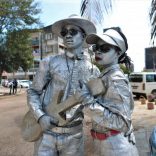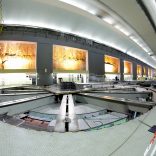Guinea revokes 46 mining licences, signalling stricter oversight of major operators
Watch: Ninth century African library founded by a woman goes digital to reach wider audience

A ninth century library in Morocco, widely believed to be the oldest in the world, is going digital to make its ancient treasures available to a wider audience.
The al-Qarawiyyin (also written Al-Karaouine) library in the former Moroccan capital, Fez, is home to some of the rarest and most unique manuscripts in the world, with access limited to just the curator in some special cases.
However, the library installed a new laboratory this year to oversee the protection and digitalizing of the 4,000 manuscripts on site in conjunction with the Institute of Computational Linguistics in Italy.
“The main aim is to provide means and tools both in terms of hardware and software to digitalise this cultural heritage and to make them available in an open way to the world at large,” said Vito Pirelli of the Italian institute.
Around 20 percent of the manuscripts have been scanned so far with machinery that is also able to identify holes in the ancient rolls that need repairing.
The digital project is part of a large building refurbishment of the library, which is expected to reopen to the public in early 2017.
The al-Qarawiyyin library was founded by a woman Fatima Al-Fihri, in 859 AD. (she also founded the Qarawiyyin Mosque and Qarawiyyin University). who inherited her merchant father’s fortunes after the family moved from Al Qayrawan, or modern day Tunisia. In “The golden age of Islam,”(French, video) a documentary that aired on France 5 Channel, Al-Fihri was described as a young woman fascinated by knowledge and curious about the world. She oversaw the construction of the mosque, and until her later years, attended lectures by reputed scholars who travelled to teach at the mosque school.
Today, the curator, Abdelfattah Bougchouf is the only person who has access to the room where the rarest texts are kept under watch from security cameras.
“What gives it (the library) its importance and value is that it contains a human heritage that interests the entire world. It is a rare heritage you will not find in other libraries. It is because of these points that we have the restoration work and the care for this library,“he said.
The library is home to some masterpieces of Islamic literature.
Among the most precious books in its archives is a 9th centre Koran written in ornate Kufic script on camel skin and Ibn Khaldun’s Mukkadimah from the 14th century.
“When you read a book, you travel in history. When you see a manuscript that is nearly ten or more centuries old, you travel in time. As I said, the library gives you a spiritual bond for these and other reasons. Since I arrived at Al Qarawiyyin Library, it never crossed my mind that I would leave it,” said deputy curator Abou Bakr Jaouane.
“The first reason that encouraged me to come to Al al-Qarawiyyin University is its reputation and the wealth of its scientific literature in every field. Researchers can find what they are looking for at this ancient and venerable universit” said a Saudi PHD student, Fahd Bin Abdelkrim.
The restored library boasts an elaborate laboratory for treating, preserving and digitising the old texts.
The library’s restoration is part of a large project to give a face lift to the old quarters of Fez known as the Medina.
The old city, granted UNESCO World Heritage status, has a large pedestrian network and is not accessible by cars.
The restoration work is expected to be completed in early 2017 when it will be opened to the general public.













Leave a Reply
Be the First to Comment!
You must be logged in to post a comment.
You must be logged in to post a comment.